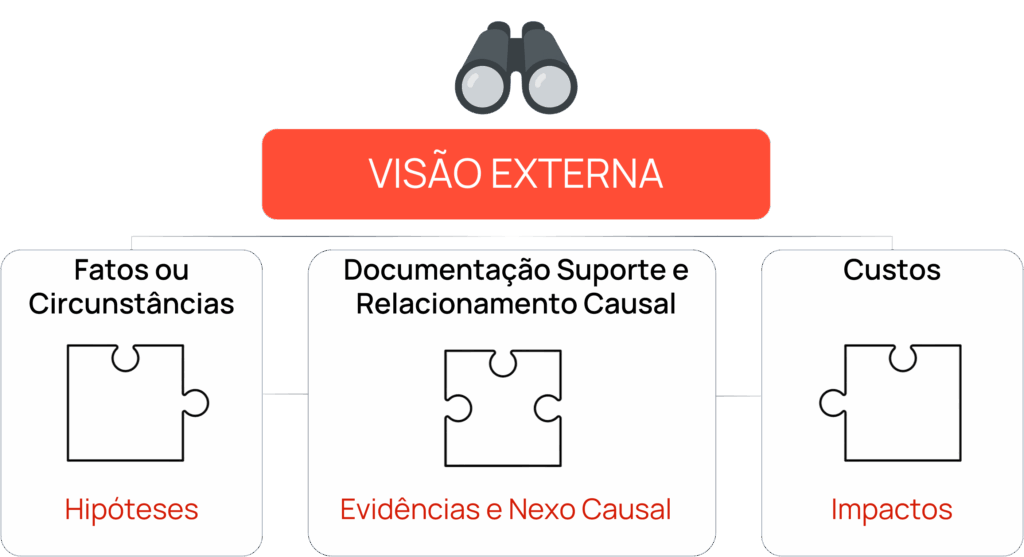Loss of productivity in construction is a common challenge that can significantly reduce the profit margin of a project. Several facts can trigger this unproductivity , from external interference to unexpected work conditions, resulting in labor costs and expected equipment. In these scenarios, the claim for loss of productivity , a technical and formal claim to recover the damage caused by this inefficiency. In international contracts, this situation is often called disruption , that is, disturbance or interruption of normal work methods that leads to a drop in efficiency. When events outside the construction of the construction company cause this loss of income, the contractual claim becomes fundamental to restore financial balance, preventing the contractor alone with extra costs due to factors alien to its responsibility.
In the context of engineering works, a “disruption” can manifest in many ways, for example in earthmoving operations that require more resources and time than planned due to unforeseen conditions. In other words, the contractor ends up performing services less efficiently than the originally expected, requiring more workers, equipment or materials to achieve the same result. Situations Thus show the importance of a well -based technical claim: In addition to identifying the event causing unproductivity, it is necessary to demonstrate the causal link between this event and the increase in costs or hours worked. Only with a careful analysis and robust documentation can the client or referees of the validity of the compensation claimed.
What is a claim for loss of productivity
A productivity loss claim is essentially a claim (claim) in which the construction company requests compensation or economic and financial rebalancing the impacts of a lower than expected work efficiency. In engineering projects, productivity refers to the level of efficiency in the use of labor and equipment-how many resources are required to perform a certain task. When any change in the initial contract conditions causes a reduction in this efficiency, generating the need to mobilize more resources to comply with the scope, there is room for a productivity loss claim. Unlike deadlines (schedule delays), productivity claims are based on additional costs incurred by increasing employed resources, even if the end of the work is not necessarily affected.
To configure a valid election, it is essential that the loss of productivity derives from a change in the originally agreed contractual conditions , not internal management failures. Unpredictable events, omissions or interference of the contractor, fortuitous cases and other causes of others to the contractor's responsibility characterize these changes in condition. In contrast, inefficiencies due to planning errors, incorrect sizing of teams or mismanagement of work management do not entitle to claim - in such cases the loss of productivity is considered risk of the executor himself and not a contractual imbalance.
Common causes of unproductivity
Several factors can lead to a loss of productivity in engineering works, even without changing the formal scope of the contract. Among the most common causes of unproductivity (or disruption ) are project changes and working conditions that escape the expected. For example:
- Incomplete or incorrect executive projects generate rework and breakdown of the rhythm of services;
- Different conditions of the site of the work as soil with characteristics not foreseen in project, may change the executive methodology;
- Problems of access to the site or delay in release of service fronts by the customer.
All of these events tend to disturb the normal sequence of work, forcing the contractor to change constructive methods, relocate teams or work at a different pace than planned - with loss of efficiency. Other sources of unproductivity may include:
- Methodology changes imposed during the work;
- Extreme climatic conditions not foreseen.
The common denominator is that such factors introduce obstacles or interruptions into the expected work pace, reducing the productivity of the applied resources.
It is noteworthy that unproductivity is not always accompanied by delay in the schedule . It is possible for a work to finish on time, but with much higher costs due to inefficiencies (overtime, additional teams) not foreseen. Likewise, delays may occur without loss of productivity - for example, a team may be waiting for the client's (delay) work front release, but when active, it yields as expected (normal productivity). The distinction between delay and unproductivity will be detailed below, as each situation generates a different type of claim.
Difference between delay and loss of productivity
Although related, delay in the schedule and loss of productivity are different concepts in construction management and result in different types of claims.
Delays relate to non -compliance with schedule dates - post -delayed critical activities that delay the completion of the project. If a significant delay occurs due to a reasons not attributable to the builder (for example, waiting for complementary client projects), a deadline extension election may be presented, adjusting the end date of the work. These delay claims are focused on time : they involve schedule analyzes and critical path, and seek to reward the contractor with more term (and sometimes additional indirect costs) to meet the contract.
Loss of productivity focuses on labor/equipment performance additional costs incurred to maintain production. A claim for unproductivity does not necessarily seek to change the deadline, but to recover financially what was spent more due to the inefficiency caused by external factors. In other words, in productivity loss claims, the contractor may have even received the work on time, but at the expense of more intensive use of resources from the construction company (more hours of work, more machines) than originally planned. These extra costs, if resulting from changes in contractual conditions, are claimed via the case even if the schedule has been maintained
Therefore, delay x unproductivity summarizes two different dimensions of impact: the delay affects the contractual term and is measured in days (implying term extension claims), while unproductivity affects efficiency/cost and is measured in cash (implying financial claims for economic rebalancing). Both phenomena can occur simultaneously in a problematic project, but must be analyzed and claimed separately, with distinct methodologies and foundations for each type of CLAIM.
Technical and legal bases of a claim
To succeed, a productivity loss claim needs to rely on solid bases, both technical and legal. technical point of view , it is essential to prove with facts and data that there was a real impact on productivity due to specific events. This means presenting field records, productivity rates before and after, service orders, work diaries, among other evidence showing the drop in performance. From the legal/contractual , it is necessary to frame these facts in terms of contract and law, demonstrating that they configure an unspoken imbalance and, therefore, generate the right to compensation.
According to good international practices, the formulation of a Claim must be "anchored in concrete, documented and legally sustainable facts." In other words, each claim in the claim must be supported by contemporary documentation of the work and supported by contractual clauses or relevant legal principles. AACE (Association for the Development of Cost Engineering) has developed practice No. 25R - 03 and is one of the main references for calculating unproductivity in the international market.

It is also important to emphasize the appearance of causal nexus : the direct connection between the event occurred (eg, a defective project or an unquited interference) and the loss of productivity alleged. It is not enough to list problems that occurred in the work; It is necessary to make it clear how each problem affected the efficiency of execution, resulting in more hours or resources spent. This technical demonstration of cause and effect, coupled with adequate contractual basis, constitutes the core of the successful claim.

Accepted methods of analysis and quantification of productivity loss
One of the challenges in unproductivity claims is to quantify reliably how much less (or cost more) was produced due to inefficiency. There are several methods accepted to analyze and measure this loss of productivity in works, each with precision degrees and different data requirements. HKA in its report “ The Analysis and Valuation of Disrupt ” divides into three main groups:
1. Methods based on project practice
These are methods that use the project records themselves to calculate losses and damage. Examples:
- Measred Mile
- Base Line Productivity Analysis
- Systems dynamics modeling
- Added value analysis
- Sampling and comparative studies
2. Industry -based methods
They use external references to the project, such as manuals or case studies, which may be:
- Specific sectoral studies that deal with topics such as acceleration, learning curve, overtime, climate, etc.
- General industry studies , based on widely accepted sources.
3. Cost -based methods
Used when it is possible to prove the right to the claim and causality, but the project data is not sufficient to apply the previous methods. They are based on project cost records , focusing on direct hours and costs of direct labor , excluding materials, equipment, indirect costs, small tools, etc.
Main methods:
- Total Cost : The estimated cost of the incurred real cost of the real cost to identify the overcustom.
- Modified total cost : equal to the previous one, but disregards estimates or inefficiencies of the contractor's responsibility . Therefore, it is the most accepted between the two.
Importance of Documentation and Contemporary Records
Contemporary records those produced at the time of events - are fundamental to prove both the occurrence of the causative event and its effects on productivity. Therefore, one of the main recommendations in contract management is to maintain detailed and organized documentation throughout the work . This includes work diaries reporting obstacles and measures taken, progress reports pointing out deviations, dated photos illustrating adverse conditions, email exchanges and formal letters notifying problems, among others.
During execution, the team should be advised to immediately record any abnormal event and its impact, however small. For example, if a service front was paralyzed waiting for the release of the area, the diary should write down how many workers were idle on that day and which activity was prevented. If there was rework by project error, you should document how many overtime were spent more and in which places. These field records, combined with contractual documents (contract, additives, schedules), allow us to build the causal link and quantification of the claim much more robustly.
Additionally, organizing documents so that they can easily be accessed and understood by third parties (experts, committees, referees) facilitates analysis and can prevent disputes on facts. It is recommended to number evidence, make cross -references in the text of the election and, if possible, summarize the findings in tables or graphs. Consistent documentation also conveys good faith and professionalism by the construction company.
Ultimately, the quality of the records can determine the success of the claim: “When the contractor needs to allocate more personal or equipment than normal to perform a particular service, he should receive it” , ie the better this increase in resources is, the more likely to be reimbursed by the costs of unproductivity . A well -documented election is not only more convincing in direct negotiation, but also provides a solid position if the dispute evolves into expert or arbitral instances. Therefore, investing time and effort in contractual administration and organized evidence is not a bureaucracy - but a project of financial protection of the project.
Contractual Administration and Technical Assistance
Implementing a claim effectively requires a proactive contractual management posture throughout the project. Contractual administration must act to prevent imbalances and treat them timely. In major works, it is highly recommended to designate a dedicated contract administrator, with traffic between the field teams, to centralize this control. Typical attributions of this professional include constant monitoring of possible contract deviations , monitoring the economic and financial balance, strategic record of relevant occurrences, formal communication with the client about any deviations and preparation/negotiation of claims when necessary. This anticipatory performance avoids the surprise of claims only at the end - conflicts are being managed as they arise, increasing the chance of friendly solution.
Allied to this, having specialized technical assistance can be decisive in the most complex cases. Technical assistance here refers to the support of professionals or experienced consultants in Claims and Expertise, who provide independent analysis and additional technical basis to claims. In legal or arbitral disputes, for example, it is common for each party to indicate a technical assistant to follow the official expertise and issue opinions that support their point of view. Although the court's report appointed by the court is the main document, a opinion of the technical assistant, well -grounded in rules and facts, may have great weight in the judge's decision.
But it is not necessary to wait for disputes to use this expertise - already in the negotiation phase of the election , technical consultants can help better structure the argument and calculations, giving more credibility to the request. The external look often identifies CLAIM opportunities or documentation failures that would go unnoticed by the internal team busy with the work.
In short, the contractual administration well done and the technical assistance are two pillars that complement each other. On the one hand, careful contract management generates the necessary records and notifications and maintains the customer informed, reducing friction. On the other hand, when differences become disputes, technical advice provides specialized support to prove the merit and value of the claim. Together, these factors increase the construction company's safety and bargaining power, while speeding up the resolution of contractual conflicts.
Conflict resolution strategies: negotiation, DRB and arbitration
Even with all the care in the reasoning, it is possible for the contractor to resist initially to recognize the loss of productivity. In such cases, there are strategies for resolution of disputes that can be triggered to seek a fair agreement or solution, avoiding or minimizing the conventional litigious pathway.
Direct negotiation: It is the most immediate means and usually the least conflicting. It consists that the parties negotiate a friendly adjustment - whether an additional payment, a commercial discount or another form of compensation - based on the arguments and evidence presented in the claim. Often a good negotiation avoids the need to climb the conflict. It is important, however, to reach the negotiating table with all the documents and technical analyzes, to convince the customer of the merits of the order.
Dispute Resolution Board (DRB): In larger works, especially infrastructure, it is common for the contract to provide a neutral dispute resolution committee , known as the DRB. It is an extrajudicial and preventive of conflict resolution, consisting of an independent group of experts (usually three, with technical and legal knowledge) that is formed early in the contract and follows its progress. The committee holds periodic meetings and visits to the construction site to stay up to date on the project, being available to technically analyze the claims submitted to it and issue exempt recommendations. The DRB also acts preventively , that is, it seeks to resolve impasses during execution, before formal disputes become.
Arbitration: If the friendly pathways (negotiation, committees or mediation) are exhausted and the impasse persist, it remains to resort to arbitration (if provided for in contract) or the Common Justice. Arbitration is a private means of conflict resolution in which the parties choose impartial referees, usually contracts and engineering experts, to judge the case . In construction contracts, arbitration is widely used for allowing a technical judgment and in a shorter period than the judiciary. However, both arbitration and judicial dispute tend to be more costly and time consuming , and often become inevitable when contractor and contractor positions crystallize.
In short, the order of preference in contractual disputes of work is usually: first, direct negotiation; If it fails, alternative mechanisms such as DRB or mediation; and, finally, arbitration or legal action. Each stage resolved amicably represents saving of time and resources for both sides.
Conclusion
Productivity loss claims are legitimate and necessary instruments to ensure the contractual balance in engineering works impacted by unforeseen events. However, to be effective, they require a high degree of technical and organizational dominance by the responsible team. Technical Domain for productivity, identify and quantify impacts accurately; Organizational domain to strategically record and respect contractual procedures. When such a claim is built with rigor and clarity, it not only increases the chances of success in obtaining compensation due, but also contributes to more professional and transparent relationships in the construction sector.
By adopting transparent, technical and anticipatory practices, it is possible to avoid claims and treat potential conflicts in a consensual and timely manner. With proper support - whether through a dedicated contractual manager, specialized technical advice or clear control methodologies - contractors and contractors gain more security and fluidity in the execution of contracts, ensuring that the unforeseen work does not compromise their viability.
Anticipate your loss of productivity
For engineers and contract managers, the warning is: anticipate productivity problems before they become costly disputes . Implement a robust contractual administration, train your team about rights and duties provided for in contract and maintain a crop of detailed records in the flowerbed. At the first sign of disruption , technically evaluate the impact and formally notify the contractor - agility and foundation are valuable allies. If necessary, do not hesitate to seek specialized technical assistance to strengthen your claim. Remember that a successful election begins long before the elaboration of the document itself: it begins in the daily discipline of monitoring, registering and reacting strategically to the events of the work. With strategic and technical preparation, your team will be able to claim effectively, protecting the financial health of the project and the company.




